
 Hogs Haven
Hogs Haven
ESPN
Back in 2012, Washington appeared to have a QB savior in Robert Griffin III, a dynamic Heisman winner who bested Andrew Luck and Russell Wilson to win NFL Rookie of the Year.
Then came the first quarter of a wild-card game against Seattle, when Griffin’s right knee buckled. Rather than putting in backup Kirk Cousins, coach Mike Shanahan stuck with the clearly compromised Griffin.
It was a brutal watch. The offense sputtered to just 41 yards en route to a loss. Worse, Griffin didn’t just look hurt, but immobilized to a degree that made him incapable of defending himself against further injury. It was a train wreck in progress. Griffin eventually crumbled after hyperextending his knee while reaching for a low snap.
Days later, he underwent surgery. He was never the same player again.
He accounted for 27 touchdowns before the injury; just 26 over the rest of his career.
Washington, meanwhile, didn’t win a playoff game until a dozen years later. That’s when another Heisman-winning, rookie sensation led the Commanders to last season’s NFC Championship Game.
The circumstances, and hopefully the severity, of Daniels’ elbow dislocation are different than RGIII’s career-altering knee, of course. Different players, different coaching staffs, different types of injury (non-throwing arm for Daniels).
The same battle-hardened fans, though, saw another breathtaking talent go down in an avoidable heap as Washington trailed 34-7 with just 7:38 remaining.
“Why is he still in the game?” RGIII himself said in a social media video, echoing the cries that once rang out for him.
Protecting your quarterback isn’t about softening the standards of football. It’s about valuing your players; a tough, if essential, concept in the ultimate team game. There is a reason NFL rules hardly allow two-hand touch on a QB.
Daniels has been sacked 17 times in six games he has played this season. He has been “hit” 322 times across the last two — most in the NFL.
The franchise which, after failing to protect their last young star quarterback, spent years searching for a new one, now needs to remind itself of a lesson that should have already been learned.
ESPN
Here is where it gets tricky and all of the factors that make an athlete’s case unique to him come into play. Generally speaking, yes, in the case of the non-throwing arm an athlete could potentially return before full healing while wearing a protective brace. For an injury to the throwing arm, that is obviously not an option. But beyond the ability to potentially return sooner with an injury to a non-throwing arm, questions remain as to whether the athlete can still effectively play the position as well as what the larger goals are for the athlete and the organization, both within the current season and beyond.
In the case of Daniels, consider that he has...